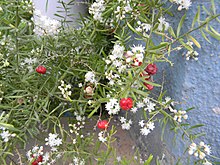| Shatavari | |
|---|---|

| |
| Plant photographed at Pune | |
| Scientific classification | |
| Kingdom: | Plantae |
| Clade: | Tracheophytes |
| Clade: | Angiosperms |
| Clade: | Monocots |
| Order: | Asparagales |
| Family: | Asparagaceae |
| Subfamily: | Asparagoideae |
| Genus: | Asparagus |
| Species: | A. racemosus |
| Binomial name | |
| Asparagus racemosus Willd. | |
| Synonyms | |
Asparagus racemosus (satavar, shatavari, or shatamull, shatawari) is a species of asparagus native from Africa through southern Asia, including the Indian subcontinent, to northern Australia. It grows 1–2 m (3 ft 3 in – 6 ft 7 in) tall and prefers to take root in gravelly, rocky soils high up in piedmont plains, at 1,300–1,400 m (4,300–4,600 ft) elevation. It was botanically described in 1799. Because of its multiple uses, the demand for Asparagus racemosus is constantly on the rise. Due to destructive harvesting, combined with habitat destruction, and deforestation, the plant is now considered "endangered" in its natural habitat.
Description

Asparagus racemosus is a climber having stems up to 4 m long. Its roots are both fibrous and tuberous.
Shatavari has small pine-needle-like phylloclades (photosynthetic branches) that are uniform and shiny green. In July, it produces minute, white flowers on short, spiky stems, and in September it fruits, producing blackish-purple, globular berries. It has an adventitious root system with tuberous roots that measure about one metre in length, tapering at both ends, with roughly a hundred on each plant.
Uses
Shatavari is used in Indian traditional medicine. Despite its long history of use in Ayurveda, no high-quality clinical evidence exists to support using shatavari as a therapy for any disease. Studies of its effects on lactation have shown mixed results. Its safety has not been well-studied, with two small trials finding no adverse effects in mothers or their babies. Constituents of shatavari include steroidal saponins, mucilage, and alkaloids.
Australian aboriginal uses
The roots of Asparagus racemosus are boiled and give a liquid used as an external wash to treat colds and other sicknesses, by the aborigines of the Moyle River area in the Northern Territory. (The Ngan'gi name for the plant is yerrwuwu.)
Chemical constituents
Asparagamine A, a polycyclic alkaloid was isolated from the dried roots and subsequently synthesized to allow for the construction of analogs.
Steroidal saponins, shatavaroside A, shatavaroside B, filiasparoside C, shatavarins, immunoside, and schidigerasaponin D5 (or asparanin A) were isolated from the roots of Asparagus racemosus.
Also known is the isoflavone 8-methoxy-5,6,4'-trihydroxyisoflavone 7-O-β-D-glucopyranoside.
See also
- Shatavar Vatika Herbal Park, Hisar, Haryana—a herbal park in India for the research, preservation and production of Ayurveda products, including shatavari
References
- ^ "Asparagus racemosus". Germplasm Resources Information Network. Agricultural Research Service, United States Department of Agriculture. Retrieved April 25, 2009.
- "Asparagus racemosus Willd." Plants of the World Online. Royal Botanic Gardens, Kew. Retrieved 2023-01-12.
- ^ H. T. Clifford, J. G. Conran (2020). "Asparagus racemosus". Flora of Australia. Canberra: Australian Biological Resources Study, Department of Agriculture, Water and the Environment. Retrieved 2021-03-21.
- Robert Freeman (February 26, 1998). "LILIACEAE – Famine Foods". Centre for New Crops and Plant Products, Department of Horticulture & Landscape Architecture. Purdue University. Retrieved April 25, 2009.
- ^ Pizzorno Jr., Joseph E.; Murray, Michael T.; Joiner-Bey, Herb (2015). The Clinician's Handbook of Natural Medicine (3rd ed.). Churchill Livingstone. p. 516. ISBN 9780702055140.
- Hechtman, Leah (2018). Clinical Naturopathic Medicine (2 ed.). Elsevier. pp. 879, 908. ISBN 9780729542425.
- Goyal, R. K.; Singh, Janardhan; Lal, Harbans (September 2003). "Asparagus racemosus—an update". Indian Journal of Medical Sciences. 57 (9): 408–414. PMID 14515032.
- ^ "Wild asparagus". LactMed. National Library of Medicine, US National Institutes of Health. 16 August 2021. PMID 30000872. Retrieved 31 March 2022.
- ^ Patricia Marrfurra McTaggart; Molly Yawalminny; Mercia Wawul; et al. (2014). "Ngan'gikurunggurr and Ngen'giwumirri plants and animals". Northern Territory Botanical Bulletin. 43: 166. Wikidata Q106088130.
- The Ley Group: Combinatorial Chemistry and total synthesis of natural products Archived May 25, 2012, at the Wayback Machine
- Sekine, T. (2010). "ChemInform Abstract: Structure of Asparagamine A (I), a Novel Polycyclic Alkaloid from Asparagus racemosus". ChemInform. 26 (5): no. doi:10.1002/chin.199505264.
- Total Synthesis Of The Antitumor Agent Asparagamine A retrieved 11-02-2011 Archived April 25, 2012, at the Wayback Machine
- Sharma, U; Saini, R; Kumar, N; Singh, B (2009). "Steroidal saponins from Asparagus racemosus". Chemical & Pharmaceutical Bulletin. 57 (8): 890–3. doi:10.1248/cpb.57.890. PMID 19652422.
- Hayes, Patricia Y.; Jahidin, Aisyah H.; Lehmann, Reg; Penman, Kerry; Kitching, William; De Voss, James J. (2008). "Steroidal saponins from the roots of Asparagus racemosus". Phytochemistry. 69 (3): 796–804. Bibcode:2008PChem..69..796H. doi:10.1016/j.phytochem.2007.09.001. PMID 17936315.
- Saxena, V. K.; Chourasia, S (2001). "A new isoflavone from the roots of Asparagus racemosus". Fitoterapia. 72 (3): 307–9. doi:10.1016/s0367-326x(00)00315-4. PMID 11295314.
External links
Categories:- Asparagus
- Flora of Africa
- Flora of Australia
- Flora of Cambodia
- Flora of Java
- Flora of Madagascar
- Flora of Malaya
- Flora of Myanmar
- Flora of Oman
- Flora of Thailand
- Flora of the Indian subcontinent
- Flora of the Lesser Sunda Islands
- Flora of the Maluku Islands
- Flora of Tibet
- Flora of Vietnam
- Flora of Yemen
- Plants described in 1799